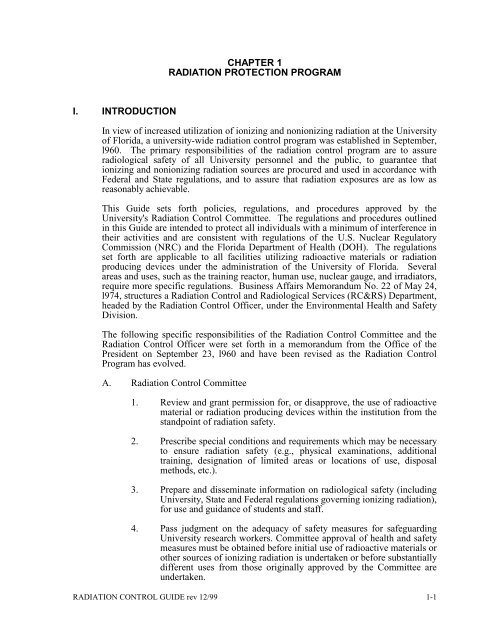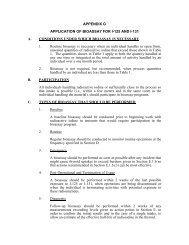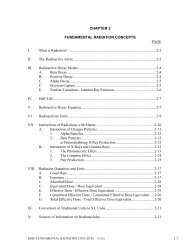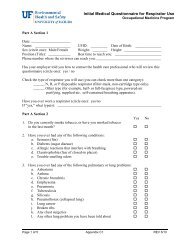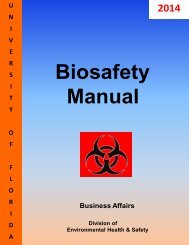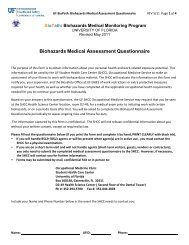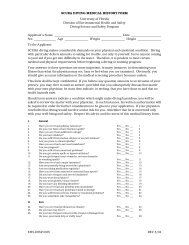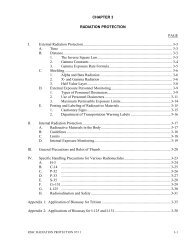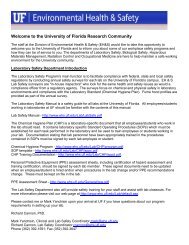CHAPTER 1 RADIATION PROTECTION PROGRAM I ...
CHAPTER 1 RADIATION PROTECTION PROGRAM I ...
CHAPTER 1 RADIATION PROTECTION PROGRAM I ...
You also want an ePaper? Increase the reach of your titles
YUMPU automatically turns print PDFs into web optimized ePapers that Google loves.
<strong>CHAPTER</strong> 1<strong>RADIATION</strong> <strong>PROTECTION</strong> <strong>PROGRAM</strong>I. INTRODUCTIONIn view of increased utilization of ionizing and nonionizing radiation at the Universityof Florida, a university-wide radiation control program was established in September,l960. The primary responsibilities of the radiation control program are to assureradiological safety of all University personnel and the public, to guarantee thationizing and nonionizing radiation sources are procured and used in accordance withFederal and State regulations, and to assure that radiation exposures are as low asreasonably achievable.This Guide sets forth policies, regulations, and procedures approved by theUniversity's Radiation Control Committee. The regulations and procedures outlinedin this Guide are intended to protect all individuals with a minimum of interference intheir activities and are consistent with regulations of the U.S. Nuclear RegulatoryCommission (NRC) and the Florida Department of Health (DOH). The regulationsset forth are applicable to all facilities utilizing radioactive materials or radiationproducing devices under the administration of the University of Florida. Severalareas and uses, such as the training reactor, human use, nuclear gauge, and irradiators,require more specific regulations. Business Affairs Memorandum No. 22 of May 24,l974, structures a Radiation Control and Radiological Services (RC&RS) Department,headed by the Radiation Control Officer, under the Environmental Health and SafetyDivision.The following specific responsibilities of the Radiation Control Committee and theRadiation Control Officer were set forth in a memorandum from the Office of thePresident on September 23, l960 and have been revised as the Radiation ControlProgram has evolved.A. Radiation Control Committee1. Review and grant permission for, or disapprove, the use of radioactivematerial or radiation producing devices within the institution from thestandpoint of radiation safety.2. Prescribe special conditions and requirements which may be necessaryto ensure radiation safety (e.g., physical examinations, additionaltraining, designation of limited areas or locations of use, disposalmethods, etc.).3. Prepare and disseminate information on radiological safety (includingUniversity, State and Federal regulations governing ionizing radiation),for use and guidance of students and staff.4. Pass judgment on the adequacy of safety measures for safeguardingUniversity research workers. Committee approval of health and safetymeasures must be obtained before initial use of radioactive materials orother sources of ionizing radiation is undertaken or before substantiallydifferent uses from those originally approved by the Committee areundertaken.<strong>RADIATION</strong> CONTROL GUIDE rev 12/99 1-1
5. Keep records of the actions taken in approving the use of radioactivematerials and other sources of ionizing radiation and othertransactions, communications and reports involved in the work of theCommittee.6. Delegate to the Radiation Control Officer the authority to act for theCommittee between meetings. His actions will be reported to theCommittee for review at appropriate intervals.7. Review plans for all new buildings and modifications of existingstructures where radioactive material or radiation producing devicesare to be used.8. Recommend and implement procedures for radioactive waste disposal.9. Periodically review actions of the Reactor Safety ReviewSubcommittee.10. Review at least annually from a radiation safety standpoint, theactivities of the Committee on Human Use of Radioisotopes andRadiation.11. Review all ongoing projects at timely intervals.12. Provide advice to research groups, departments and investigators.B. Radiation Control Officer (RCO)1. Administer the overall day-to-day programs of the University'sRadiation Control Office.2. Approve all University procedures which might conceivably involveradiation exposure and all changes in such procedures. By agreement,the University maintains exclusive control over, and responsibility for,the use of radioactive materials and radiation producing devices at allShands facilities. Approval by the RCO of the policies and proceduresat these facilities, from the radiation safety standpoint, is performed atthe respective department level.3. Act in a supervisory capacity in all aspects of radiation measurementand protection activities, such as personnel monitoring, maintenance ofexposure records, survey methods, waste disposal and radiation safetypractices.4. Consult with potential radioactive material users and advise onradiation safety practices.5. Suspend any operation causing excessive radiation hazards as rapidlyand safely as possible. In carrying out this duty the Radiation ControlOfficer will report directly to the Director, EH&S, and inform theChairman, RCC.1-2 <strong>RADIATION</strong> CONTROL GUIDE rev 12/99
6. Maintain a list of employees who work with radioactive materials andradiation producing devices.7. Prescribe routine radiation surveying and personnel monitoring.8. Establish standardized procedures for the procurement of radioactivematerial, receiving and opening packages of radioactive material,storing radioactive material, inventory record of radioactive material,use radioactive materials safely, take emergency action if control ofradioactive material is lost, perform periodic radiation surveys,perform checks of survey instruments and other safety equipment,dispose of radioactive materials, train personnel who work in orfrequent areas where radioactive material is used or stored , maintain acopy of all records and reports required9. Serve as ex-officio member of all radiation safety committeesconstituted at the departmental, college, experiment station, clinic oruniversity levels.10. Additional duties and responsibilities for the Radiation Control Officerare specified in 64E-5.605, F.A.C., and 64E-5.1305, F.A.C.C. Responsibilities of Principal InvestigatorThe Principal Investigator also shares the responsibility for the safe use ofradioactive materials and radiation producing devices, specifically:1. Administer and enforce safety rules and regulations as stated in theRadiation Control Guide which are necessary to the radiation controlprogram in all areas within the scope of their authority.2. Inform all employees of potential health hazards and the necessarysafeguards which are established to guard against them.3. Ensure that all employees working with, or in the vicinity of,radioactive materials or radiation producing devices are properlytrained and monitored.4. Inform the Radiation Control Office of all changes in personnelworking with radioactive materials or radiation producing devices andchanges in facilities or use locations.5. Maintain control over radioactive material and maintain adequateinventory and utilization records. Perform weekly contaminationsurveys when radionuclides are in use.6. Ensure that all radioactive waste is received by the Division ofEnvironmental Health and Safety for ultimate disposal.7. Ensure safe and secure storage of all radioactive material.D. The Radiation Control Officer and/or Radiation Control Committee maydisapprove or terminate any project involving serious or continued violation ofthe standards set forth in this Radiation Control Guide.<strong>RADIATION</strong> CONTROL GUIDE rev 12/99 1-3
II.ALARA POLICYA primary goal of the radiation protection program is to reduce radiation doseswherever and whenever reasonably achievable, thereby reducing the health risk that isassumed to be proportional to the radiation dose. The As Low As ReasonablyAchievable Policy (ALARA Policy, Appendix I) adopted by the University describesthe commitment to keep radiation doses ALARA, the actions to be taken andradiation dose guidelines. The ALARA Policy for the JHMHC, and Shands HealthCare Facilities is available from the Radiation Control Office.III.OCCUPATIONAL DOSE LIMITSA. Occupational Dose Limits for AdultsOccupational dose limits for adults are specified by Federal regulations as setforth in the Code of Federal Regulations, Title X, Part 20, "Standards forProtection Against Ionizing Radiation," and by the Florida Department ofHealth, "Control of Radiation Hazard Regulations", Chapter l0D-91 (asamended July 1997). These limits are listed in Appendix D.Since any radiation exposure is undesirable, it is important that all exposuresbe kept as low as reasonably achievable. The permissible ALARA radiationdose levels used at the University of Florida are more conservative than theState or Federal Regulations and are listed below.Investigation Levels for Radiation Exposure (per calender quarter) 1Total Effective DoseEquivalent (whole body);orSum of the deep-doseequivalent and thecommitted dose equivalentto any organ of tissue otherthan the lens of the eyeLens of the eye (eye doseequivalent)Skin (shallow doseequivalent or to anyextremityLevel I Level II Level III125 mrem(1.25 mSv)1250 mrem(0.0125 Sv)375 mrem(3.75 mSv)1250 mrem(0.0125 Sv)375 mrem(3.75 mSv)3750 mrem(0.0375 Sv)1125 mrem(0.01125 Sv)3750 mrem(0.0375 Sv)1 Bi-monthly Investigation levels are 2/3 of the quarterly levels1250 mrem(.0125 Sv)12500 mrem(0.125 Sv)3750 mrem(0.0375 Sv)12500 mrem(0.125 Sv)Specific approval to operate under the more liberal State or Federalregulations must be obtained for any such occasion from the RadiationControl Committee and/or Human Use of Radioisotopes and RadiationCommittee by submitting a written proposal through the Radiation ControlOfficer.1-4 <strong>RADIATION</strong> CONTROL GUIDE rev 12/99
B. Occupational Dose Limits to MinorsOccupational exposure to any individual who is under the age of 18 ispermitted only if their exposure is limited to ten percent or less of the limitsspecified above for adult workers. For this reason, it is recommended thatminors not be employed as full-time occupationally exposed workers.C. Dose to an Embryo or Fetus for Women Who Have Declared PregnancyThe dose to an embryo or fetus during the entire pregnancy from occupationalexposure of a declared pregnant woman shall not exceed 0.5 rem (5 mSv). Itis recommended that not more than 0.05 rem (0.5 mSv) be received by theembryo or fetus in any one month.Approved users at the University of Florida should be aware of the fact thatthe Nuclear Regulatory Commission (NRC) and the State of Florida requireinstruction of occupational workers in the hazards associated with radioactivematerial and radiation, and in the precautions and safety measures to befollowed to minimize radiation exposure. These basic requirements arecontained in 10 CFR 19.12., and 64E-5.902.The NRC and State has advised its licensees that such instruction must includespecial instructions to females of childbearing potential, regarding the risks tothe unborn fetus associated with prenatal radiation exposure. In addition to theinstruction requirement, the NRC and State require that special efforts bemade to limit any exposure to the developing fetus.The NRC has issued a regulatory guide to assist licensees in achievingcompliance with this requirement. The regulatory guide requires that:1. Women in jobs involving radiation exposure must be explicitlyadvised of the risk associated with prenatal exposure.2. Particular efforts must be made to keep the radiation exposure of theembryo or fetus to the very lowest practical level during the entiregestation period in accordance with the National Council on RadiationProtection (NCRP), a recommendation adopted by the NRC and State.3. Female employees must be advised that the NRC and State haveregulations to ensure that the dose to an embryo or fetus during theentire pregnancy from occupational exposure of a declared pregnantwoman does not exceed 0.5 rem (5 mSv).The requirements of 10 CFR 19, 64E-5 and the Regulatory Guide have beenreviewed by the Radiation Control Committee and the following policies havebeen established:1. An employee information packet (see Appendix E) has been preparedby the Radiation Control Office and distributed via the PrincipalInvestigator, to all women who work with radioactive material and/orradiation producing devices or who have access to such areas.2. Each woman receiving the information packet should be given theopportunity to ask questions regarding the regulations.<strong>RADIATION</strong> CONTROL GUIDE rev 12/99 1-5
3. An attempt to selectively apply this requirement to certain womenwould necessitate soliciting personal information regarding fertility,intentions with respect to pregnancy, etc. Such questions are andwould most certainly be so regarded as an invasion of privacy.Consequently, at the University of Florida, the information about risksof prenatal radiation exposure will be made available to all femaleemployees and students.4. As an approved user and supervisor, the Principal Investigator isresponsible to ascertain that all female occupational workers areapprised of the risks of prenatal radiation exposure. He/She must alsotake steps to minimize exposure to female employees who are or whomay be pregnant; make the information packet available to all womenwho work with radioactive material and/or radiation producing devicesor who have access to such areas under his/her supervision, andprovide all current and new women employees with an opportunity toask questions concerning the regulations, the information packet andthe levels of radiation exposure likely to be received as a result ofcurrent or future job assignments he/she have made or may wish tomake.While the information packet may appear to be directed only to "employees",it must be noted that female undergraduate and graduate students, as well asfaculty members and research assistants, must receive these instructions. Itshould be understood that this instruction packet is intended to apply equallyto all occupational workers including users of x-ray diffraction units and x-raymachines, as well as radionuclide users.In order to assist you, the following steps have been taken:1. Arrangements have been made with the appropriate University officesin order to insure that applicants are advised that the positions in whichthey are interested involve work with radioactive materials and/orradiation producing devices or access to such areas prior to thesupervisory interview. Thus, it is important that you informappropriate offices on all future personnel requisitions initiated to fillpositions for occupational workers and for others whose duties requirefrequent access to such areas. Correspondence for new staff and therequisitions for employees filed with the Division of HumanResources, Student Employment Office, or the Dean of the GraduateSchool, should contain an explicit and clear comment, i.e., "Thisposition requires work with radioactive materials and/or radiationproducing devices or access to such areas". In order to insure thatprospective occupational workers are fully informed prior toacceptance of your position, the employee or the student orientationobviously must include a discussion of the possible fetal radiationexposure risk involved and the duties, activities and job assignmentsyou have or will establish for the position.As an approved user and supervisor, the Principal Investigator bearsthe ultimate responsibility to make certain that all female occupationalworkers have received the information packet and that they haveacknowledged receipt thereof.1-6 <strong>RADIATION</strong> CONTROL GUIDE rev 12/99
2. The Radiation Control Office is prepared to assist you in explainingthis requirement to small groups (up to 10 persons), as arranged by thedepartment and with the participation of the approved users.The operation of this program will obviously require the careful and timelyreview of radiation exposure reports and appropriate action taken. If theradiation exposure reports are sent to a designated departmental contact ratherthan the approved user, as is sometimes done as a convenience to thedepartment, the Principal Investigator must take steps to insure that the contactkeeps him informed of the exposure to their personnel. It will also require thatthe Radiation Control Office be kept informed of the names of those personswho are using radioactive materials or radiation producing devices under thePrincipal Investigator’s supervision.D. Maximum Permissible Exposures to Concentrations of Radioactive Materialin Restricted AreasNo Principal Investigator or approved user shall possess or use radioactivematerials in such a manner as to result in an individual being present in anarea where airborne radioactivity is present. In the event airborne radioactivityis suspected, the Radiation Control Office should be contacted immediately.E. Reporting OverexposuresIn the event an exposure occurs which is suspected to exceed the University'spermissible exposure limits (Page 4), the Radiation Control Officer is to benotified immediately.The Principal Investigator responsible for the area in which a radiationexposure equal to or exceeding the University's permissible exposures occursshall provide the Radiation Control Office with written details of the exposureand describe procedures which will be followed to prevent recurrence of suchan exposure.IV.<strong>RADIATION</strong> SAFETY CRITERIA VIOLATION ENFORCEMENT POLICYA. IntroductionThe Radiation Control Committee recognizes the good working relationshipsbetween the RCO and Principal Investigators (P.I.) and that continuednoncompliance with established safety rules is a rare occurrence. TheCommittee recognizes the possibility of a problem and has established a threestage follow-up enforcement program. The policy outlined below retains theinitial follow-up authority with the RCO but establishes a more formalizedprocedure with deadlines. If the initial efforts of the RCO are unsuccessful,the Radiation Control Committee will involve itself and take steps asappropriate to obtain compliance.<strong>RADIATION</strong> CONTROL GUIDE rev 12/99 1-7
B. Enforcement Follow-up ProceduresInitial Follow-upFollowing the identification of a deficiency in radiation safety criteria, theRCO and/or his designee will notify the P.I. in writing. A suggestion of howcompliance with University requirements can be achieved will be includedand the P.I. will be asked to notify the Radiation Control Department within10 days of the status of his efforts to make the correction. To facilitatecompliance on the part of the P.I., a standard Action Taken Form (ATF) willbe utilized on which the violation will be identified with space to identify thecorrection carried out.If the violation is of a major nature, the laboratory will be scheduled for afollow-up inspection.Department Head NotificationIf the RCO and/or his designee is not able to achieve compliance through theinitial efforts outlined above, the status of the situation will be brought to theattention of the P.I.'s department head. The department head will be asked toassist the RCO and/or his designee in making the corrections. If for anyreason this second stage does not achieve compliance, the Radiation ControlCommittee will intercede.Radiation Control CommitteeIf direct action of the RCO and the requested assistance of the departmenthead has not achieved correction of a safety violation, the RCC will take directaction. The Committee will review the situation to determine the seriousnessof the identified violation and the action of the investigator. The P.I. will berequested to meet directly with the Committee to outline why he has notcomplied. The Committee will take whatever action is appropriate to achievecompliance. The action may vary from situation to situation, but could be fullsupport of the RCO's action to remove the P.I.'s approval to work withradioactive material.Three ATF’s received by a Principal Investigator within the past 12 months isconsidered to be continued noncompliance and results in direct intervention bythe Chair of the RCC.1-8 <strong>RADIATION</strong> CONTROL GUIDE rev 12/99


